Contents
- First Things First – What is Marketing Attribution?
- What is Marketing Attribution Software?
- Benefits of Marketing Attribution Software
- Types of Attribution Tools and Software
- What to Look For in Marketing Attribution Software
- Other Considerations When Selecting a Marketing Attribution Tool
- Why OptiMine?
How to Choose Marketing Attribution Software
01/24/2022
Marketing attribution software plays a pivotal role in unraveling the complex customer journey by providing insights into which channels and touchpoints are driving results. However, selecting the right marketing attribution software can be daunting amidst a plethora of options. In this blog post, we’ll explore the different types of marketing attribution as well as key considerations and factors to help you navigate the landscape and choose the best marketing attribution software for your business needs. Let’s get started!
First Things First – What is Marketing Attribution?
In short, Marketing Attribution is the process of evaluating the marketing touchpoints a consumer encounters on their path to purchase. It then assigns value or credit to a set of advertisement impressions that contribute to a desired outcome (Example: conversions).

What is Marketing Attribution Software?
Marketing attribution software is a crucial tool for businesses and marketers to understand and measure the impact of various marketing channels and touchpoints on their overall sales and conversions. This software helps in identifying which specific marketing efforts contribute to customer acquisition and conversion, providing insights into the customer’s journey. It allows businesses to assign credit to different marketing channels, such as social media, email, paid advertising, and more, based on their role in influencing a customer’s decision to make a purchase.
By tracking and analyzing user interactions across multiple platforms and campaigns, marketing attribution software helps companies optimize their marketing strategies and allocate their budget more effectively, ultimately improving their return on investment (ROI) and the overall efficiency of their marketing efforts.
Benefits of Marketing Attribution Software
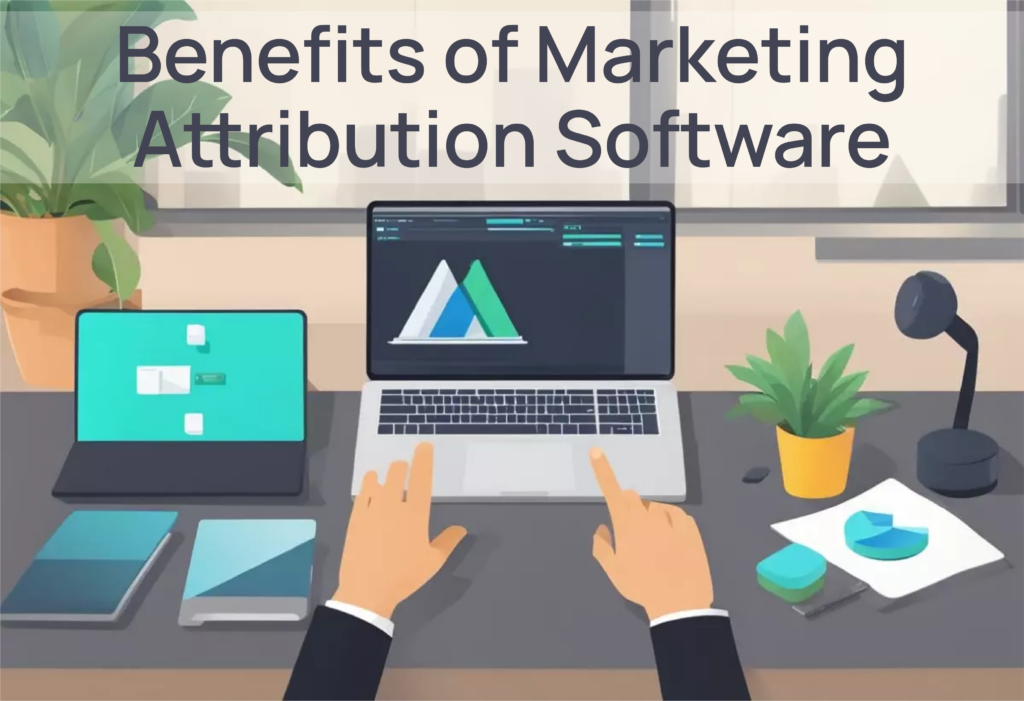
Marketing attribution software provides many benefits for businesses and marketers for several compelling reasons:
- Optimizing Marketing Budget Allocation – By understanding which strategies are driving conversions, brands can allocate their budget more efficiently, focusing resources on the most productive channels and eliminating underperforming ones.
-
Improving ROI – With a clear understanding of what works and what doesn’t, brands can enhance their return on investment. They can invest more in high-performing marketing efforts and reduce spending on less effective ones, ultimately increasing profitability.
-
Informed Decision-Making – Data-driven attribution enables businesses to make informed decisions about marketing strategy adjustments, creative content, and targeting, offering a more objective basis for decision-making.
- Cross-Channel Coordination – Attribution software helps brands understand how different touchpoints work together to drive conversions, which is essential for a seamless and effective omnichannel marketing strategy.
-
Measuring Long-Term Impact – Attribution software can account for the long-term effects of marketing efforts, acknowledging that a customer’s decision-making process may take time. It helps identify brand-building activities that may not result in immediate conversions but contribute to long-term success.
-
Reducing Wasteful Spending – By pinpointing redundant or ineffective marketing efforts, attribution software helps eliminate wasteful spending on activities that do not contribute significantly to the bottom line.
-
Aiding Marketing Experimentation – With attribution insights, businesses can run controlled experiments to test new marketing strategies and assess their impact accurately. This allows for continuous optimization and innovation in marketing campaigns.
-
Alignment of Marketing and Sales Teams – Attribution software can help bridge the gap between marketing and sales teams by providing a common language for evaluating performance, which can lead to better collaboration and shared goals.
Types of Attribution Tools and Software
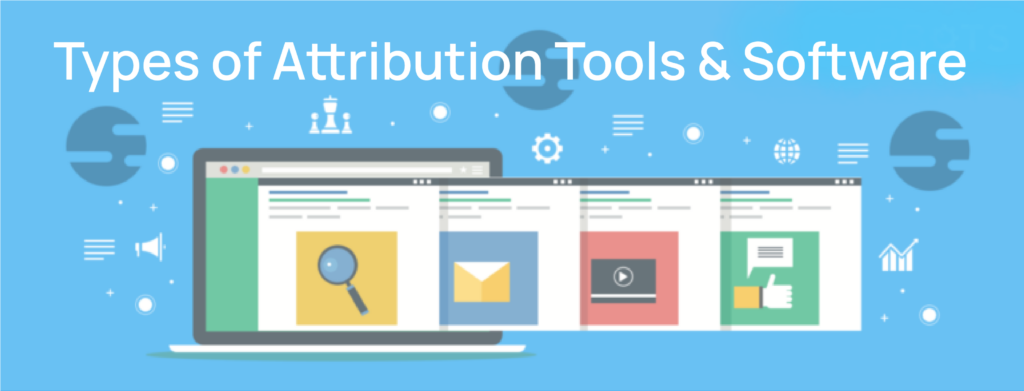
Today’s marketing attribution approaches range from the most basic and simplistic all the way to highly sophisticated platforms. Most rely on a combination of clicks, cookies, consumer and device tracking and PII. For an in-depth summary of today’s marketing attribution options, read OptiMine’s Marketing Attribution blog post. But here’s a brief overview:
- Last-Touch Attribution – The simplest form of marketing attribution, assigns full credit for the conversion to the last ad clicked.
- First-Touch Attribution – Also a simple form of marketing attribution, assigns full credit for the conversion to the first ad clicked.
- Fractional (or Rules-Based) Attribution – Attempts to assign weights, factors or “rules” to give credit to different points in the funnel.
- “U” and “W” Shaped Attribution – Also attempts to assign weights, factors or “rules” to give credit to different points in the funnel— usually by assigning more credit to the first and last ads in the sequence.
- Algorithmic Attribution – A more complex approach that sometimes uses predictive models and correlations to calculate credit across ad sequences.
- Custom Attribution Models – Some businesses create their own attribution models tailored to their specific needs, considering factors unique to their industry or customer behavior.
- Multi-Touch Attribution Software – These tools are designed to track and analyze the customer journey across various channels and touchpoints, but this method was never very accurate or reliable to begin with – and is now under significant privacy pressure. We think it is safe to say that MTA is no longer a viable method of marketing measurement, or in other words… Multi-Touch Attribution is Dead.
- Marketing Mix Modeling (MMM) – Evaluates the impact of both online and offline marketing efforts on sales and conversions, considering factors like TV, radio, and print advertising, in addition to digital channels. OptiMine is a modern, agile Marketing Mix Modeling software solution that is 100% privacy-safe!
What to Look For in Marketing Attribution Software
Like any marketing measurement approach, there are many considerations to keep in mind as you seek the best tool for the job at hand. With marketing attribution, there are some serious challenges to keep front and center, whether you already have an attribution solution deployed or are looking to implement a new one:
| Criteria | Important Notes & Considerations |
Marketing Coverage |
Does the solution cover all of the marketing channels for your brand (including traditional media such as TV, radio, print, OOH)? |
Conversion Coverage |
Does the solution cover all of the conversion channels for your brand (including in-app, in-store, call center, branch locations, sales agents, in addition to e-commerce)? |
Controlling for Non-Marketing Factors |
Does the modeling solution account and control for non-marketing factors (weather, seasonality, competition, economy) as well as your brand’s own non-marketing impacts (promotions, discounts, PR, events, sponsorships)? |
Avoiding Reliance on PII |
Does the solution require PII? Can the solution provide detailed campaign-level measures without the use of PII? |
Need for Speed |
Does the solution require data integrations, use of 3rd party data onboarding, tagging digital assets, matching offline consumer data, or other data-related tasks that greatly slow down deployments and updates over time? |
Flexibility First |
How easy can the solution change to new KPIs or conversion outcomes? How fast and easy is it to add new channels and data? How long must the solution recalibrate models when data changes? How long does it take to build new models? How often are the predictive models updated? |
Hidden Costs |
Does the solution require additional expenses for data, data integration, web development, compliance costs, and IT costs? |
Other Considerations When Selecting a Marketing Attribution Tool
Build vs. Buy
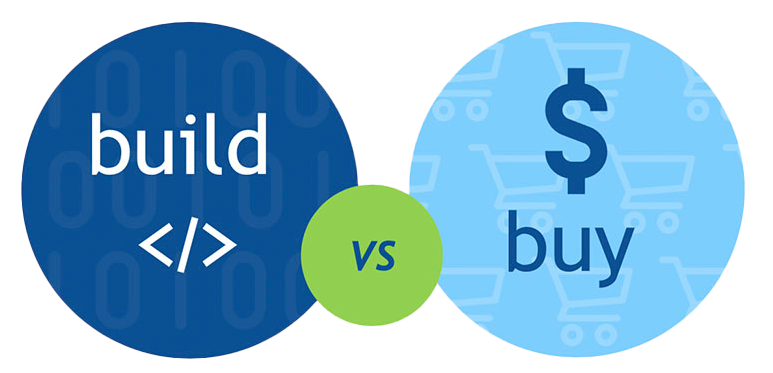
One primary consideration when looking for a new marketing attribution solution is to consider building a solution internally vs. licensing a solution from a vendor in the market. How to weigh your options?
Think about your analytic resources and staffing levels first. Does your analytics team have available capacity to develop an in-house solution? Does your brand have the requisite data science, predictive modeling and data engineering skills and experience to build a custom solution? Lastly, are there other high-priority projects, deliverables or efforts that will be stopped as a result of a dedicated in-house build? One rule of thumb to keep in mind: it may take an experienced team upwards of 9-12 months to build a capable measurement solution, and will require continuous “care and feeding” once built. This is not a simple, quick one-time project. And if your brand must hire new resources to put towards such an effort, consider the costs of hiring and compensating new staff vs. the license expense of a 3rd party vendor solution.
When considering a vendor solution in the market, start with a well defined set of requirements first. Does your brand use both digital and traditional advertising channels? Most marketing attribution solutions only focus on digital channels. Does your brand have both online and offline conversions? Again, most attribution solutions only measure online conversions. Lastly, is you brand (and compliance group) comfortable with the use of PII (and the data loss & accuracy issues that come with PII) for an attribution solution? Most, but not all, attribution vendors require the use of PII for their solutions.
Beware of Relying Solely on Marketing Platforms & Publishers
Many brands simply rely on the measurement tools available from the Walled Gardens, their advertising agencies, or from publisher / ad network platforms. Brands must also recognize the inherent conflict of interest involved in relying on these sources of measurement: they are “grading their own homework”. Skeptical of this? Try this exercise: add up the “credit” for all campaigns across these various platforms, partners and tools. If the “credit” exceeds the actual amount of your brand’s revenues, you’ve now confirmed the issue. (Hint: most brands have 3-6X actual revenues when they go through this exercise).
Data Loss
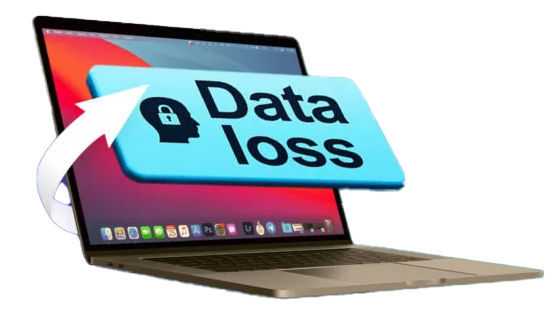
With data loss due to cookie death but also importantly due to Apple’s iOS / ATT privacy changes which has caused approximately 40% of the mobile advertising space in the US to go dark. And the data loss trend will continue: Apple’s MPP has already caused significant portions of the email tracking space to go dark, and Google’s FLoC initiative will stop all individual targeting and tracking in 2023. One thing is clear: data loss is going to get a lot worse over the next 1-2 years.
Why does this matter for marketing attribution? Even small data gaps (e.g. mis-matches or gaps between identifying who was exposed to an ad and whether they converted) throw giant accuracy problems into marketing attribution models that rely on identity tracking.
Privacy

Major new consumer privacy regulations in the US (California, Colorado, Virginia, the list goes on… and is just going to keep on growing) have introduced significant new risks to brands that capture, store, share, sell and use personally identifiable information (“PII”).
Why does this matter for marketing attribution? If your brand uses consumer data tracking at the core of your marketing attribution, you have significant new risks and complexities as a result of these regulations, even if you use a 3rd party vendor.
Cost

There are many hidden, and costly, expenses when deploying a tracking-based marketing attribution solution- costs that many brands may not originally factor into the TCO of the attribution solution:
-
- Marketing attribution solution licensing fees: this is the expense most brands focus on, and licensing costs for a marketing attribution solution can be significant, but are only one part of the cost picture.
- 3rd party identity data licenses, processing costs: a brand must also license, access and store identity data and pay for processing their own customer data to match third party identity graphs. Note: this expense is triggered when a brand chooses an attribution solution that relies on consumer tracking.
- Integration and ongoing maintenance expense: the web design team placing pixels, tracking code and building out back-end customer data integrations is only part of the expense. When the brand decides to ask a different question, measure a new KPI or track differently, these expenses often multiply.
- Regulatory compliance costs: If a consumer in California decides to exercise their new right “to be forgotten” from a data privacy standpoint, the brand must comply and be able to demonstrate that this request has been fully honored. How many systems, vendors and databases does your brand have that house, use or leverage PII? Complying with the simple request to remove this PII data isn’t so simple, and isn’t “free”.
Technical Inflexibility (AKA “Brittleness”)
When using a tracking-based marketing attribution platform, if the data you decide to collect doesn’t change, things are a little easier to manage. But the reality is that brands are dynamic businesses reacting to new market pressures, evolving product strategies and consumer choices & demands. The probability that what a brand’s marketing team measures will remain static over time is nearly zero. A hidden cost of new questions, KPIs and data sources is that the brand must re-tag digital assets, collect new types of data, and recalibrate (or in most cases build new) models. This is hard. And is a significant hidden expense for marketing attribution solutions.
Why OptiMine?
OptiMine provides several advantages over traditional consumer tracking-based approaches to attribution such as Multi-Touch Attribution (“MTA”). And when brands seek a more future-proof approach to attribution that doesn’t use PII (for example, traditional Marketing Mix Modeling or, “MMM”), there are even more tradeoffs and weaknesses that OptiMine helps leading brands overcome.
A Future-Proof Marketing Attribution Tool:
We’re now well into a major era of privacy-driven data disruption. Attribution approaches that require PII are no longer safe, accurate nor reliable moving forward. OptiMine’s approach uses no PII data whatsoever and delivers a 100% future-proof solution for brands.
Agility:
Speed matters now more than ever. The brands with the best intelligence combined with speed will outperform those brands who lag in these areas. OptiMine delivers the fastest solution in the market, providing the quickest ramp to ROI, and promises speed and flexibility for the long haul.
Comprehensive Cross-Channel Measurement & Optimization:
The days of having to combine MTA and marketing mix modeling (“MMM”) solutions to get complete marketing and conversion coverage are over. OptiMine provides a truly unified measurement and optimization solution that covers both traditional and digital marketing across online and offline conversions all in one single solution and modeling methodology. No more conflicting answers, measurement gaps, and solution complexity. OptiMine is the only truly unified solution in the market. Period.
See below an outline of the many advantages OptiMine provides when considering a marketing attribution solution:
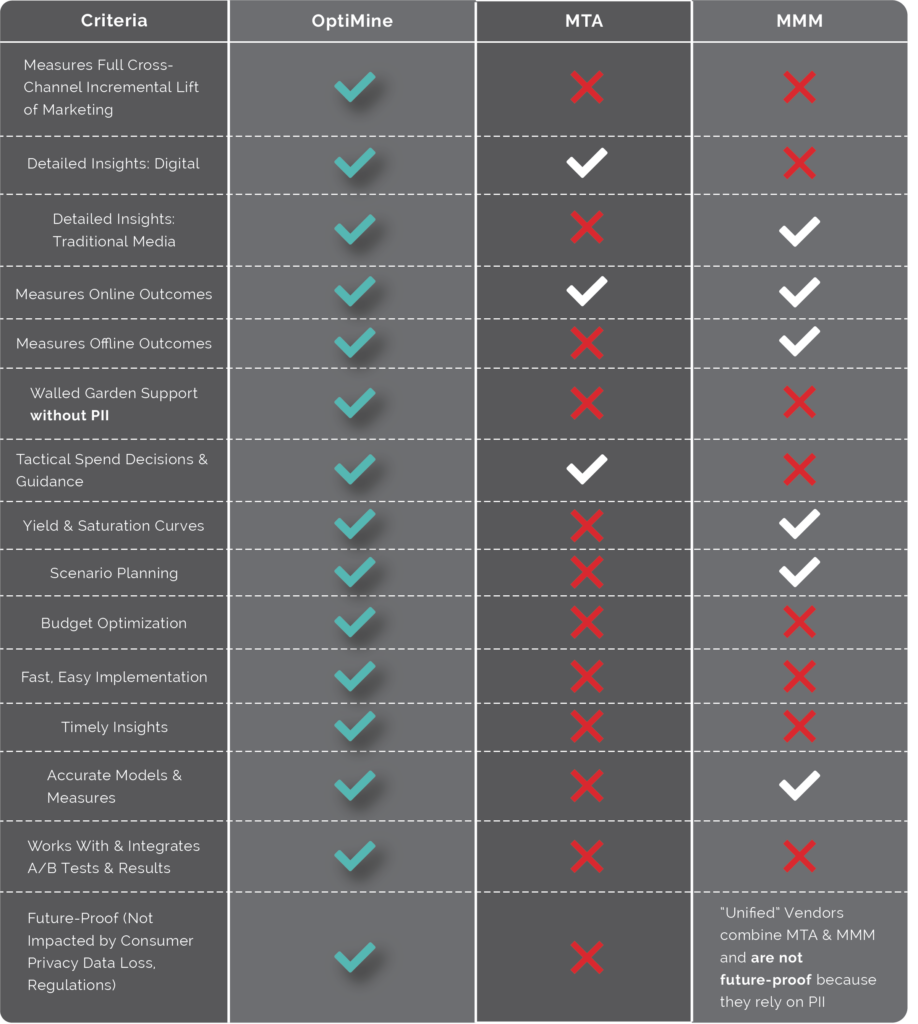
Interested in learning more about how OptiMine’s marketing attribution tools can help you? Contact us today!
More Resources:
- “What is Marketing Mix Modeling (MMM)?” Blog Post
- “What is Incrementality in Marketing?” Blog Post
- “Marketing Attribution FAQ” Blog Post
- OptiMine On-Demand Webinar: “Apple’s ATT Changes Are Now Live. Learn How It’s Impacting Brands’ Measurement, Performance, & How to Move Forward”
-
OptiMine x TickPick On-Demand Presentation: “ARF Measurement Challenges Showcase”

